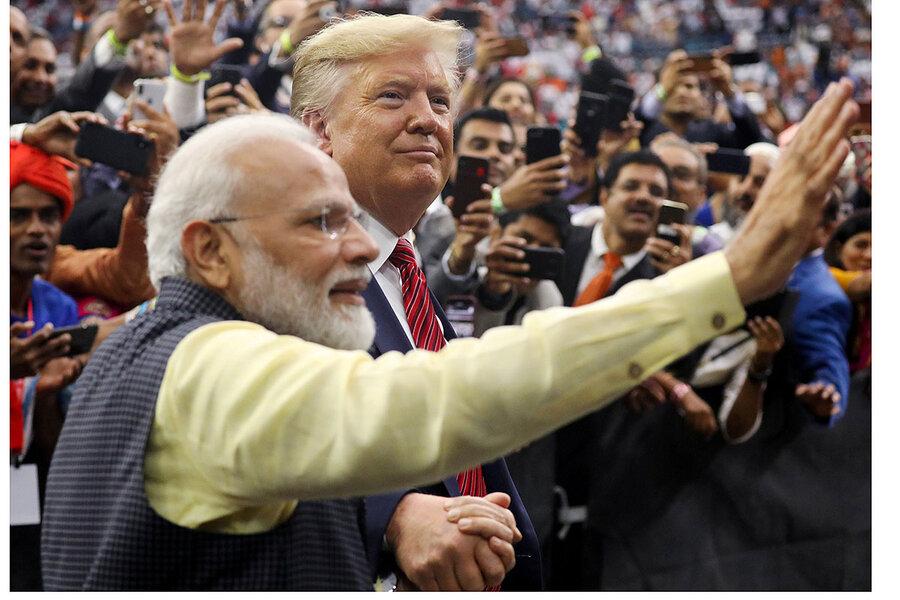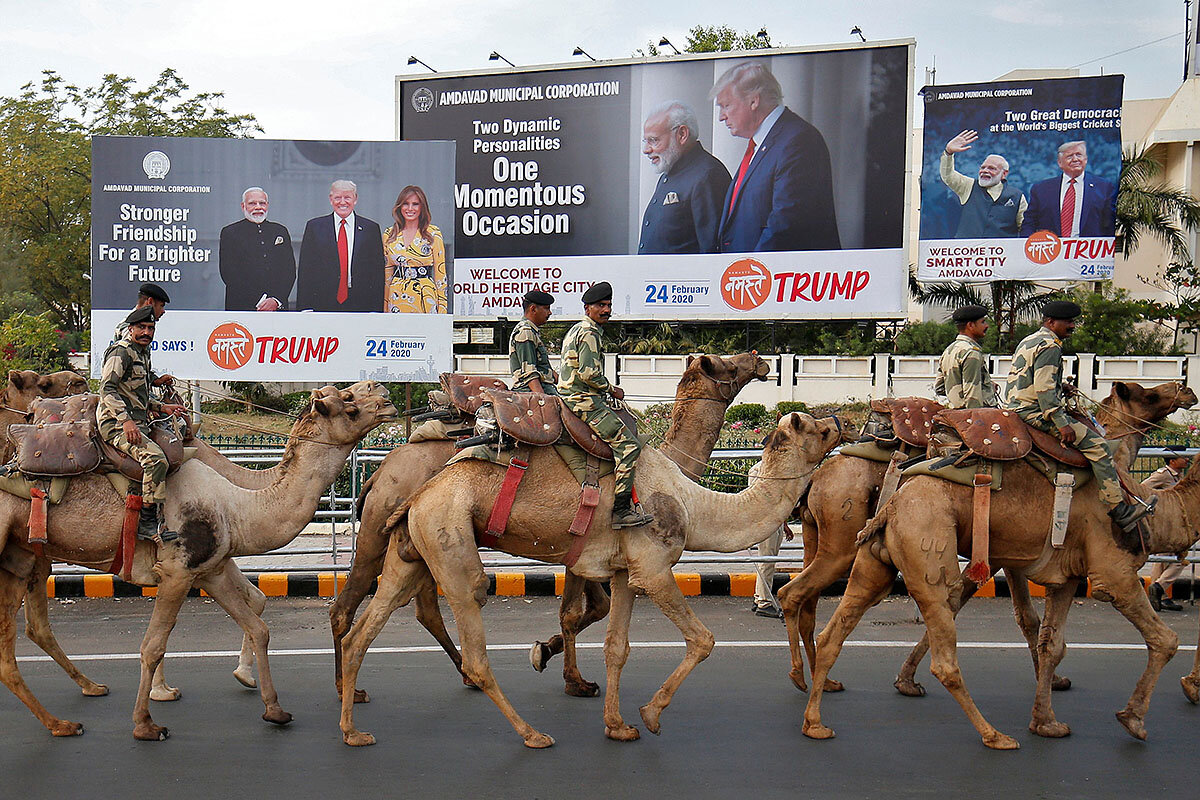From vision to spectacle – the optics of Trump’s trip to India
Loading...
| Washington
By almost any measure, the Trump administration has elevated India in the hierarchy of U.S. strategic relationships to a level envisioned but never attained under recent administrations.
On the eve of President Donald Trump’s trip to India next week, the South Asian country stands at the center of his administration’s Indo-Pacific strategic vision for cementing U.S. influence and countering a rising China across Asia.
Under President Trump, the United States has joined with India to begin fashioning an infrastructure development alternative to China’s Belt and Road Initiative for a booming Asia. Diplomatic and defense cooperation between the world’s two largest democracies has advanced to a level approaching that of other key non-NATO allies.
Why We Wrote This
How to draw in an American president? India is at the center of the Trump administration’s strategic vision for countering a rising China in Asia. But the country’s real allure may be the promise of adoring crowds.
Perhaps most gratifying to India, the U.S. no longer sees the relationship primarily through the lens of the India-Pakistan confrontation.
“There was a time when a Pakistan visit would have been an automatic part” of any American leader’s trip to India, says Jeff Smith, South Asia research fellow at the Heritage Foundation’s Asian Studies Center in Washington. Mr. Trump’s trip to India only, with no reflexive Pakistan stop, “is a sign we’ve de-hyphenated the relationship.”
Yet none of that may be the central reason a president notoriously impatient with long-distance overseas travel will make a trip to India beginning Sunday that will have him in the air almost as much time as on the ground.
Great optics
Instead, the showman in Mr. Trump appears to have been enticed by plans for a Bollywood-worthy event with Indian Prime Minister Narendra Modi in a stadium of 100,000 cheering fans – bigger by far than any of the president’s recent “Keep America Great” rallies.
Add to that the promise of a motorcade route lined with 7 million waving well-wishers – Mr. Trump keeps repeating that 7 million figure in amazement, although it is not clear exactly where it came from – and it becomes evident why the president is making India his showcase foreign travel of a year otherwise largely dedicated to his reelection campaign.
Indeed India, with its 1.3 billion people, is one of the few countries in the world – Israel may be another – where positive views of Mr. Trump outweigh negative assessments, according to recent international polling.
That, together with the ebullient reception that the visiting Indian leader and his host received from thousands of Indian Americans at last year’s “Howdy, Modi!” rally in Houston, appears to have convinced Mr. Trump that India will be his kind of place.
“Prime Minister Modi will make an extra effort on great optics,” says Tanvi Madan, director of the Brookings Institution’s India Project in Washington. “He’ll want to be sure that President Trump, whom they see as transactional, feels like he got something” from the trip, she adds.
Showing American presidents the love is nothing new for India, Ms. Madan notes. She says President Dwight Eisenhower spoke to a throng of a half-million people during his visit in 1959, and that President George W. Bush – like Mr. Trump not generally loved internationally – was received enthusiastically in 2006.
Trip “is about continuity”
Still, she says there will not be 7 million people lining the streets for Mr. Trump, “but there will be a lot,” and the Indians are confident that, “if there are a lot of people, the president will be pleased.”
Yet even if the U.S. public’s takeaway is a spectacle rivaling anything India has ever staged for a U.S. president, many regional analysts say the visit at its core is about solidifying the great strides the U.S.-India relationship has taken over the last decade in particular.
“This trip really is about continuity,” says Bruce Riedel, a former CIA South Asia analyst and counterterrorism expert and now a senior fellow at Brookings. Since President Bill Clinton traveled to India in 2000, he says, “there has been a very strong bipartisan consensus in Washington that India really is a strategic partner.”
An India visit may now be a must for a U.S. president, Mr. Riedel says, but he underscores that if the relationship has risen in strategic importance, “it really is because institutions on both sides – particularly the military and intelligence – have come to value the relationship.”
That does not mean all is smooth sailing for the two countries.
Trade, citizenship issues
Topping a list of tensions is bilateral trade and the two countries’ inability to reach a trade deal in time for Mr. Trump’s visit. Heritage’s Mr. Smith says he was “frankly surprised” that negotiators failed to deliver a deal that Mr. Trump and Mr. Modi could sign in New Delhi. But he notes that both sides had recently taken to accusing the other of “moving the goal posts” for a trade accord.
Stubborn issues in the trade negotiations range from e-commerce regulations to opening markets to specific products, including medical supplies and almonds.
Other points of contention include India’s purchasing of military equipment from its traditional supplier, Russia – although India has increasingly turned to the U.S., buying some $17 billion in American military equipment since 2007. During the trip, the two countries will trumpet the signing of some new deals, including India’s purchase of $2.6 billion in Seahawk helicopters.
More broadly, there is growing concern in some sectors on the U.S. side over what is seen as India’s turning away from its secular and pluralistic founding principles under the Hindu nationalist Modi.
Mr. Trump will visit an India still torn by passage last December of a citizenship law widely viewed as “anti-Muslim” because it creates a path to citizenship for refugees from all religious minorities except Muslims – who at about 14% of the population make up India’s second-largest religious group.
Mr. Trump seems likely to hail India’s democratic and pluralistic traditions in his speech, some experts say, though Mr. Riedel says no one should expect the president to upbraid Mr. Modi for “Islamophobic” laws given the president’s own actions, including travel bans, that are perceived as anti-Muslim.
Afghanistan distraction?
Other “elephants in the room” of an otherwise flashy and feel-good visit, regional analysts say, will include China and Afghanistan.
The Indians are unhappy that the Trump administration appears to have afforded Pakistan a “kingmaker’s role” in the advancing negotiations between the U.S. and the Taliban that are heading toward a peace agreement between the two parties by the end of the month.
Indeed, some see the potential for an imminent U.S.-Taliban deal stealing the thunder from Mr. Trump’s India visit. A seven-day cessation of violence in Afghanistan, a precursor to the deal, is slated to begin tonight.
“If a deal really is to be signed, Trump will very much want to be in the picture,” Mr. Riedel says. “He very much wants to check the box of having done something about the endless wars.”
However, having the U.S. president participate in a signing with the Taliban would be “very risky,” Mr. Riedel says, given not only everything that could go wrong with a peace agreement over the coming months, but also given the very fresh memory many Americans have of U.S. service member deaths perpetrated by the Taliban.
Still, “it’s the kind of risk [the president] relishes taking,” Mr. Riedel says. And he takes from his recent conversations with State Department and other official contacts the hint that “a presidential side trip to Afghanistan just might happen.”
“When I ask, they all say a Pakistan stop is very unlikely,” he says. “But when I ask about Afghanistan, they all go mute.”







